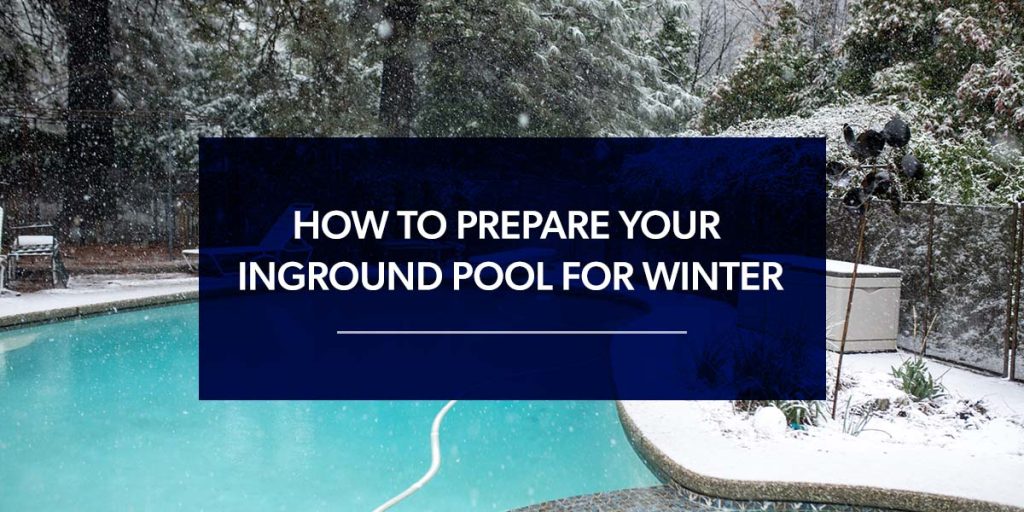

There’s no better way to welcome warmer weather than having a pool that’s ready to enjoy right away. The best way to set your pool up for maximum self-indulgence in the warm months is to winterize it. Learning how to prepare your inground pool for winter saves you all the hassle when pool season starts, so all you have to do is relax and float on by.
Getting a pool ready for winter takes time and patience. However, it’s essential, especially in areas that endure freezing temperatures. When preparing your swimming pool for the winter, you’ll shield yourself against damage and future hassles. Once it’s pool season again, a fully winterized pool will be ready to go with no hidden surprises such as algae buildup or burst pipes. Prevent unanticipated maintenance repairs and unwanted headaches by learning how to winterize your pool.
You can get your pool ready for winter by following these nine practical steps.
This tip seems pretty straightforward, but you don’t want to start the winterizing process, realize you forgot some essential items and have to run back to the store. Supplies you will need include:
When you close your pool for the winter, it should be spotless and free from any debris to avoid dirt and bacteria when you reopen it next spring. Use a pool brush to scrape off any residue stuck to the walls or the floor. Once you finish brushing, clean the pool with a pool vacuum. The vacuum will suck up any debris or algae residue taken down from brushing. Be sure to remove every last bit of debris before continuing. Algae can grow in a closed pool, so ensure your pool is flawlessly clean.
Also, collect all the toys, floaties and other pool accessories. Removing them gives you more space to clean the pool. It also helps you maintain the longevity of your pool accessories so you can use them during the following season. Save yourself time once the warmer season arrives, too, by cleaning the items before putting them away.
Once you’ve thoroughly cleaned your pool, it’s time to lower your water levels anywhere from a couple of inches to over a foot, depending on the cover you are using. A pool safety cover requires your water level to fall just below the tile line, about six to 12 inches. If you’re using a winter pool cover, the water level only has to be three to four inches below the skimmer. Follow the safety cover manufacturer’s directions to get your water levels to the desired depth.
Before you start adding any winterizing chemicals, you need to know your water’s pH balance to ensure you are adding the chemicals your pool needs.
Once you get the results back from your testing kit, you can adjust your pool with winterizing and balancing chemicals. First, you will need to shock your pool with a non-chlorine shock. Then, add the needed chemicals directly afterward. Shocking the pool first decreases your chances of opening your pool to an algae-filled infestation months later.
In addition to adding the necessary chemicals from the water test, you should also use algicide to prevent algae growth, and a metal and mineral remover to prevent metal lingering in the water.
It’s essential to clean your pool filters and pump to avoid bacteria growth over the winter. Remove the filter cartridge and clean it with a hose or a special cleaning solution, if necessary. Drain the filter so all the water is gone. That way, there is little chance for pooled water to freeze and expand your filter.
When cleaning your pump, turn the power off first to protect yourself and the equipment. Remove the water and clean the pump. Cover or move it indoors once you finish cleaning it.
Winterizing pool pipes is especially crucial if your region’s winter temperatures reach below freezing. Ice can damage your pool pipes and possibly burst them. Blowing out your water lines removes every last drop of water from the lines and pump to avoid issues that can happen when pool water reaches its freezing point. Using an air compressor attached to the drain plug opening is best for this step. Once your water lines are completely free of water, plug the lines with rubber plugs.
Before officially closing your pool, you need to shock it again. Follow the instructions of your pool shock and run the pool pump overnight. It’s best to do this step at night to prevent sunlight from intervening with the pool shock process.
Lastly, once you have completed all the other steps, it’s time to put the cover on to provide additional pool freeze protection. Be sure to follow the manufacturer’s directions to fit your pool cover on properly. It’s also best to insulate or cover the rest of your pool equipment, like the pipes, filter, pump and heater, to protect them from the elements when the pool is closed. Protecting the equipment that is necessary for running your pool will ensure you can continue using the pool for a long time.
Now, your pool is protected for winter and will be ready to enjoy again when the weather warms up.
If the steps above seem exhausting or daunting, you don’t have to prepare your swimming pool for winter on your own. To close your pool without any headaches, hire a pool professional! At Quantus Pools, we have the expertise, tools and supplies to provide top-notch swimming pool winter maintenance. We can winterize your pool to protect it all season long and complete the entire process with high quality.
Contact us online or give us a call at 847-907-4995 to get your pool in the Chicago area ready for the winter today!